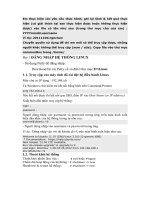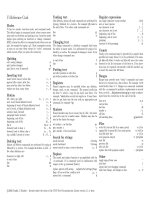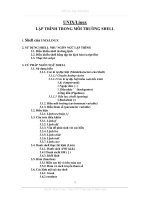lập trình shell linux
Bạn đang xem bản rút gọn của tài liệu. Xem và tải ngay bản đầy đủ của tài liệu tại đây (56.2 KB, 1 trang )
Vi Reference Card
Modes
Vi has two modes: insertion mode, and command mode.
The editor begins in command mode, where cursor move-
ment and text deletion and pasting occur. Insertion mode
begins upon entering an insertion or change command.
[ESC] returns the editor to command mode (where you can
quit, for example by typing :q!). Most commands execute
as soon as you type them except for “colon” commands
which execute when you press the return key.
Quitting
exit, saving changes :x
quit (unless changes) :q
quit (force, even if unsaved) :q!
Inserting text
insert before cursor, before line i , I
append after cursor, after line a , A
open new line after, line before o , O
replace one char, many chars r , R
Motion
left, down, up, right h , j , k , l
next word, blank delimited word w , W
beginning of word, of blank delimited word b , B
end of word, of blank delimited word e , E
sentence back, forward ( , )
paragraph back, forward { , }
beginning, end of line 0 , $
beginning, end of file 1G , G
line n n G or :n
forward, back to char c fc , Fc
forward, back to before char c tc , Tc
top, middle, bottom of screen H , M , L
Deleting text
Almost all deletion commands are performed by typing d
followed by a motion. For example dw deletes a word. A
few other deletions are:
character to right, left x , X
to end of line D
line dd
line :d
Yanking text
Like deletion, almost all yank commands are performed by
typing y followed by a motion. For example y$ yanks to
the end of line. Two other yank commands are:
line yy
line :y
Changing text
The change command is a deletion command that leaves
the editor in insert mode. It is performed by typing c fol-
lowed by a motion. For example cw changes a word. A few
other change commands are:
to end of line C
line cc
Putting text
put after position or after line p
put before position or before line P
Registers
Named registers may be specified before any deletion,
change, yank, or put command. The general prefix has
the form "c where c may be any lower case letter. For
example, "adw deletes a word into register a. It may there-
after be put back into the text with an appropriate put
command, for example "ap.
Markers
Named markers may be set on any line of a file. Any lower
case letter may be a marker name. Markers may also be
used as the limits for ranges.
set marker c on this line mc
goto marker c ‘c
goto marker c first non-blank ’c
Search for strings
search forward /string
search backward ?string
repeat search in same, reverse direction n , N
Replace
The search and replace function is accomplished with the
:s command. It is commonly used in combination with
ranges or the :g command (below).
replace pattern with string :s/pattern /string /flags
flags: all on each line, confirm each g , c
repeat last :s command &
Regular expressions
any single character except newline . (dot)
zero or more repeats *
any character in set [ ]
any character not in set [^ ]
beginning, end of line ^ , $
beginning, end of word \< , \>
grouping \(. . . \)
contents of n th grouping \n
Counts
Nearly every command may be preceded by a number that
specifies how many times it is to be performed. For exam-
ple 5dw will delete 5 words and 3fe will move the cursor
forward to the 3rd occurance of the letter e. Even inser-
tions may be repeated conveniently with this method, say
to insert the same line 100 times.
Ranges
Ranges may precede most “colon” commands and cause
them to be executed on a line or lines. For example :3,7d
would delete lines 3−7. Ranges are commonly combined
with the :s command to perform a replacement on several
lines, as with :.,$s/pattern/string/g to make a replace-
ment from the current line to the end of the file.
lines n-m :n ,m
current line :.
last line :$
marker c :’c
all lines :%
all matching lines :g/pattern /
Files
write file (current file if no name given) :w file
append file (current file if no name given) :w >>file
read file after line :r file
read program output :r !program
next file :n
previous file :p
edit new file :e file
replace line with program output :.!program
Other
toggle upper/lower case ~
join lines J
repeat last text-changing command .
undo last change, all changes on line u , U
c
2002 Donald J. Bindner – licensed under the terms of the GNU Free Documentation License version 1.1 or later.









